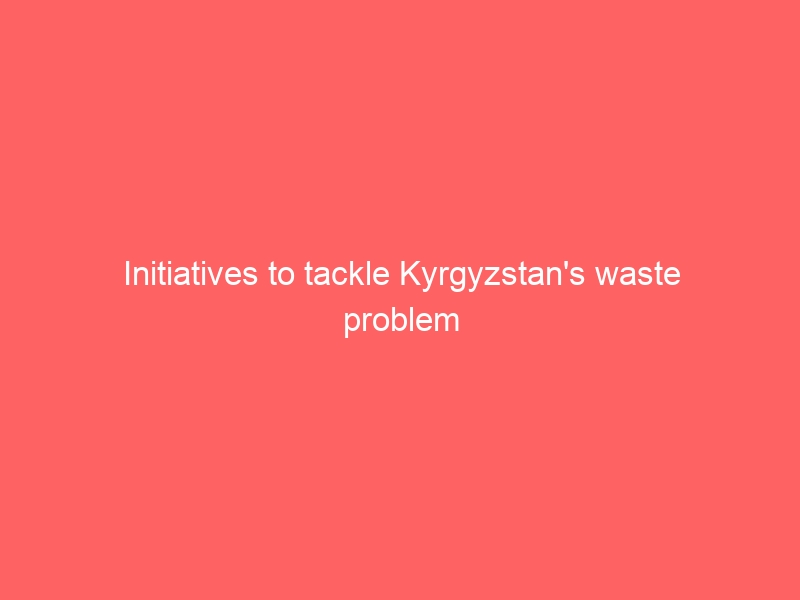Initiatives to Tackle Kyrgyzstan’s Waste Problem with New Incinerator
Kyrgyzstan, a landlocked country in Central Asia, is facing a growing waste problem. With a population of over 6 million people, the country generates approximately 1.5 million tons of waste each year. The inadequate waste management infrastructure has led to environmental degradation, health hazards, and unsightly landscapes.
In response to this pressing issue, the Government of Kyrgyzstan has taken action to address the waste problem by implementing various initiatives, including the construction of a new waste incinerator. This incinerator is expected to play a key role in reducing the volume of waste, minimizing the environmental impact, and fostering sustainable waste management practices. In this article, we will explore the initiatives to tackle Kyrgyzstan’s waste problem and the potential impact of the new incinerator.
Initiatives to Tackle Kyrgyzstan’s Waste Problem
1. Improving Waste Collection and Segregation: One of the primary initiatives to address Kyrgyzstan’s waste problem is to improve waste collection and segregation systems. Efforts are being made to increase the coverage of waste collection services, especially in rural and remote areas. Additionally, the implementation of segregation at source programs aims to encourage residents to separate their recyclable and non-recyclable waste.
2. Encouraging Recycling and Composting: To reduce the volume of waste that ends up in landfills, the government has been promoting recycling and composting initiatives. This includes the establishment of recycling centers and the support of community-based recycling programs. By diverting materials such as paper, plastics, glass, and organic waste from landfills, these efforts contribute to a more sustainable waste management system.
3. Implementing Waste-to-Energy Solutions: Another crucial initiative is the implementation of waste-to-energy solutions, such as the construction of a new waste incinerator. This technology allows for the conversion of waste into energy through the process of combustion. The resulting energy can be utilized to generate electricity or heat, providing a sustainable and environmentally friendly alternative to landfilling.
The New Waste Incinerator in Kyrgyzstan
The construction of a new waste incinerator in Kyrgyzstan represents a significant milestone in the country’s efforts to tackle the waste problem. This state-of-the-art facility is equipped with advanced technology to ensure the safe and efficient incineration of waste. The incinerator is designed to meet international environmental standards and comply with strict emission regulations to minimize its environmental impact.
Key features of the new waste incinerator include:
1. High-Efficiency Combustion System: The incinerator is equipped with a high-efficiency combustion system that allows for the complete and controlled burning of waste. This ensures the maximum conversion of waste into energy while minimizing the release of pollutants.
2. Emission Control Measures: To mitigate the environmental impact of incineration, the facility is equipped with advanced emission control measures, such as particulate filters, scrubbers, and monitoring systems. These measures are designed to capture and neutralize harmful pollutants before they are released into the atmosphere.
3. Energy Recovery Systems: The waste incinerator incorporates energy recovery systems to harness the heat generated during combustion. This thermal energy can be converted into electricity or used for district heating, contributing to the sustainable utilization of waste as a resource.
Potential Impact of the New Incinerator
The introduction of the new waste incinerator in Kyrgyzstan is expected to have a significant impact on the country’s waste management landscape. Some of the potential benefits of the incinerator include:
1. Reducing Landfill Dependency: By diverting a substantial portion of waste from landfills, the incinerator helps to alleviate the burden on existing landfill sites and prolong their lifespan. This contributes to the conservation of land and reduces the negative environmental impacts associated with landfills.
2. Energy Generation: The incinerator’s ability to convert waste into energy presents an opportunity to generate electricity and heat from a previously untapped resource. This can contribute to the diversification of the country’s energy sources and reduce reliance on non-renewable fuels.
3. Mitigating Environmental Pollution: The advanced emission control measures of the incinerator help to minimize the release of harmful pollutants, such as dioxins, heavy metals, and greenhouse gases. This contributes to air quality improvement and reduces the environmental burden of waste disposal.
FAQs
Q: Is incineration a safe and environmentally friendly waste management solution?
A: Modern waste incineration facilities are designed to meet stringent environmental standards and employ advanced emission control measures to minimize their environmental impact. When operated in compliance with regulations, incineration can be a safe and sustainable waste management solution.
Q: What types of waste can be incinerated in the new facility?
A: The new waste incinerator is capable of incinerating a wide range of waste streams, including municipal solid waste, industrial waste, medical waste, and hazardous waste. However, certain types of waste may be excluded based on regulatory restrictions and environmental considerations.
Q: How will the energy generated by the incinerator be utilized?
A: The thermal energy generated by the incinerator can be utilized for electricity generation or district heating. The choice of energy utilization will depend on local energy demand and infrastructure availability.
Q: What measures are in place to ensure the safe operation of the incinerator?
A: The operation of the incinerator is subject to strict regulatory oversight and monitoring to ensure compliance with environmental standards. Additionally, the facility is equipped with safety systems and protocols to mitigate potential risks and ensure safe operation.
In conclusion, the initiatives to tackle Kyrgyzstan’s waste problem, including the construction of a new waste incinerator, demonstrate the country’s commitment to developing sustainable waste management solutions. The implementation of these initiatives is expected to contribute to the reduction of waste volumes, environmental preservation, and the utilization of waste as a valuable resource. As the new incinerator becomes operational, it is crucial to ensure its safe and efficient utilization, while continuing to promote waste reduction, recycling, and other sustainable waste management practices.
Initiatives to tackle Kyrgyzstan’s waste problem with new incinerator




